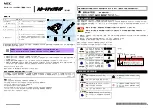
How It Fits Together
This section describes how the various diagnostic tools work together in the different
power-on modes. This description assumes you are using a graphics monitor to view
test results. The flowchart in Figure 2–1 outlines the roles played by various
diagnostics during the default boot mode.
POST runs automatically at power on, if the
Stop(L1)-d
keys are pressed and held
down after the power-on, or if the
diag-switch?
parameter is set true.
While the low-level POST code executes, the CAPS lock LED on the keyboard flashes
to indicate that testing is in progress. If a failure occurs in POST, the failing
replaceable unit is encoded on three LEDs located on the Type-5 keyboard. See
“Power-On Self Test (POST)” on page 13 later in this chapter for more information.
If POST passes, the system probes for SBus devices and interprets their drivers. Next,
high level tests are performed. The word
Testing
displays while the high level
tests are running. After
Testing
is displayed, if you want to enter the Forth Toolkit,
(indicated by the
ok
prompt), press the
Stop(L1)-a
keys simultaneously.
When the autoboot switch parameter is set to false (not the default), the
ok
prompt
appears. Table 2–1 gives the results of various combinations of the autoboot an
diagnostic switch settings. The
ok
prompt is the default prompt. To change to the
Monitor prompt (
>
) see the Open Boot 2.0 Command Reference.
If the autoboot switch parameter is set to true (default), and the diagnostic switch
parameter is set to false (default), SunOS is booted using the device alias “disk.” If
the autoboot switch parameter is set to true (default), and the diagnostic switch
parameter is set to true (not the default), SunOS is booted using the device alias “net.”
TABLE 2–1
Autoboot and Diagnostic Switch Parameters
Autoboot Switch
Parameter
Diagnostic Switch
Parameter
Results
False
(Don’t care)
ok
prompt (Forth Toolkit)
True
False
Boot SunOS (vmunix) from disk
True
True
Boot SunOS (vmunix) from network
To boot user-specified programs, such as the SunDiagnostic Executive, you must be
at the
ok
prompt. See “On-Board Diagnostics” on page 14 later in this chapter for a
detailed procedure on how to obtain the
ok
prompt.
Diagnostics Overview
11
Summary of Contents for 1.0
Page 2: ...USA 650 960 1300 fax 650 969 9131 ...
Page 3: ...SPARCstation 10 Service Manual Part No 800 6358 11 Revision A July 1993 ...
Page 16: ...xv SPARCstation 10 Service Manual Revision A July 1993 ...
Page 21: ...Figure 1 6 Exploded View of the SPARCstation 10 System MLB System Overview 5 ...
Page 26: ...Figure 2 1 Default Boot Mode Flowchart 10 SPARCstation 10 Service Manual Revision A July 1993 ...
Page 54: ...38 SPARCstation 10 Service Manual Revision A July 1993 ...
Page 88: ...72 SPARCstation 10 Service Manual Revision A July 1993 ...
Page 104: ...88 SPARCstation 10 Service Manual Revision A July 1993 ...
Page 112: ...96 SPARCstation 10 Service Manual Revision A July 1993 ...
Page 120: ...104 SPARCstation 10 Service Manual Revision A July 1993 ...
Page 190: ...174 SPARCstation 10 Service Manual Revision A July 1993 ...
Page 198: ...182 SPARCstation 10 Service Manual Revision A July 1993 ...
Page 202: ...186 SPARCstation 10 Service Manual Revision A July 1993 ...
Page 214: ...198 SPARCstation 10 Service Manual Revision A July 1993 ...
Page 220: ...Glossary 204 SPARCstation 10 Service Manual Revision A July 1993 ...
Page 221: ...Index Index 205 ...
















































